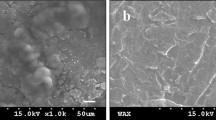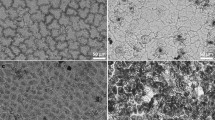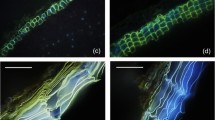Abstract
Cuticular penetration of potassium salts across astomatous cuticular membranes isolated from pear and Citrus leaves has been studied. Penetration was a first order process and was greatly affected by humidity and hygroscopicity of salts. Temperature did not significantly influence rates of penetration in the range of 10 – 25 °C. Penetration required dissolution of the salt and this is determined by the point of deliquescence (POD) and humidity. When humidity is above the POD the salt residue on the cuticle dissolves, while below a solid residue is formed and penetration ceases. The POD for K2CO3 is 44% at 20 °C and above this humidity salt penetration was possible. Rate constants of penetration increased from 0.022 to 0.045 h−1 when humidity increased from 50 to 90%. With KCl (POD of 86%) rates were highest at 90% and lower at 100% while with KNO3 (POD of 95%) and KH2PO4 (POD of 97%) highest rates were measured at 100% humidity and at 90% penetration was extremely slow. With KCl, KNO3 and K2CO3 maximum rate constants of penetration across pear CM were around 0.04 – 0.05 h−1 which correspond to half times of penetration of 14 – 17 h. Rate constants measured with Citrus CM were up to two times higher but response to humidity was similar. The potassium salts studied did not only differ in POD and sensitivity to humidity but also in potassium content, which is highest with K2CO3 (57%) and KCl (52%) and much lower with KNO3 (38%) and KH2PO4 (29%). Thus, K2CO3 is best suited for foliar applications as rates of penetration were large at 50% humidity and higher, while with the other salts humidity must be 90 – 100% for maximum rates of penetration.
Similar content being viewed by others
References
Allen M 1960 The uptake of metallic ions by leaves of apple trees. II. The influence of certain anions on uptake from magnesium salts. J. Hort. Sci. 35, 127–135.
Buchholz A and Schönherr J 2000 Thermodynamic analysis of diffusion of non-electrolytes across plant cuticles: The effects of waxes and plasticisers on the lipophilic pathway. Planta 212, 103–111.
Chamel A 1988 Foliar uptake of chemicals studied with whole plants and isolated cuticles. In Plant Growth and Leaf Applied Chemicals. Ed. Neumann P N, pp 27–50. CRC Press, Boca Raton, Fla. USA.
Kolthoff I M, Sandell E B and Bruckenstein S 1969 Quantitative chemical analysis. Macmillan, London, UK.
Krüger J 1999 Mechanistische Untersuchungen zur Permeabilität der pflanzlichen Kutikularmembranen für Calciumsalze. Doctoral Diss. University of Hannover, Germany.
Lide D R 1991 Handbook of Chemistry and Physics, 92nd edition, pp 15–21. CRC Press, Boca Raton, Ann Arbor, Boston, USA.
Marner H 1995 Mineral nutrition of higher plants. Academic Press, London, UK.
McFarlane J C and Berry W L 1974 Cation penetration through isolated leaf cuticles. Plant Physiol. 53, 723–727.
Neumann P M 1988 Plant growth and leaf applied chemicals. CRC Press, Boca Raton, Fla. USA.
Schönherr J 1976 Water permeability of isolated cuticular membranes: The effect of pH and cations on diffusion, hydrodynamic permeability and size of polar pores. Planta 128, 113–126.
Schönherr J 1982 Resistance of plant surfaces to water loss: Transport properties of cutin, suberin and associated lipids. In Physiological Plant Ecology II. Encyclopaedia Plant Physiol. Eds. Lange O L, Nobel P S, Osmond C B and Ziegler H, vol 2B, pp 153–179. Springer, Berlin, Heidelberg, New York.
Schönherr J 2000 Calcium chloride penetrates plant cuticles via aqueous pores. Planta 212, 112–118
Schönherr J 2001 Cuticular penetration of calcium salts: Effects of humidity, anions and adjuvants. J. Plant Nutr. Soil Sci. 164, 225–231.
Schönherr J and Bukovac M J 1970 Preferential polar pathways in cuticles and their relationship to ectodesmata. Planta 92, 189–201.
Schönherr J and Bukovac M J 1972 Penetration of stomata by liquids. Dependence on surface tension, wettability and stomatal morphology. Plant Physiol. 49, 813–819.
Schönherr J and Bukovac M J 1978 Foliar penetration of succinic acid-2,2-dimethyl hydrazide. Mechanism and rate limiting step Physiol. Plant. 42, 243–251.
Schönherr J and Riederer M 1986 Plant cuticles sorb lipophilic compounds during enzymatic isolation. Plant Cell Environ. 9, 459–466.
Schönherr J and Baur P 1996 The effects of temperature, surfactants and other adjuvants on rates of uptake of organic compounds. In Plant Cuticles - an Integrated Functional Approach. Ed. Kerstiens G, pp 134–154. BIOS Scientific Publ. Oxford.
Yamada Y, Wittwer S H and Bukovac M J 1964 Penetration of ions through isolated cuticles. Plant Physiol. 39, 29–32
Author information
Authors and Affiliations
Rights and permissions
About this article
Cite this article
Schönherr, J., Luber, M. Cuticular penetration of potassium salts: Effects of humidity, anions, and temperature. Plant and Soil 236, 117–122 (2001). https://doi.org/10.1023/A:1011976727078
Issue Date:
DOI: https://doi.org/10.1023/A:1011976727078




